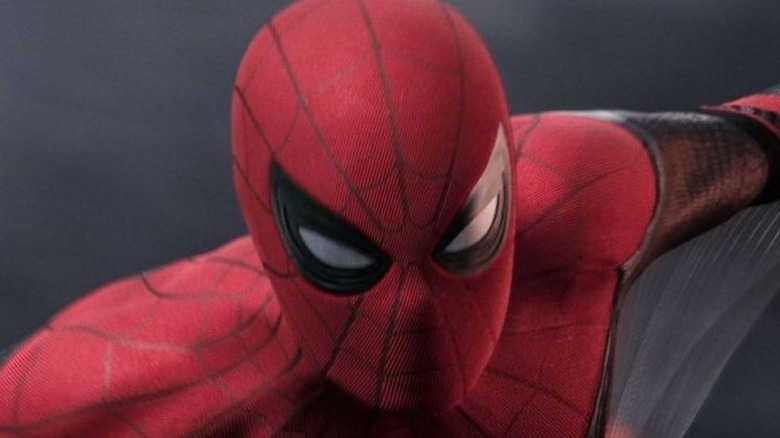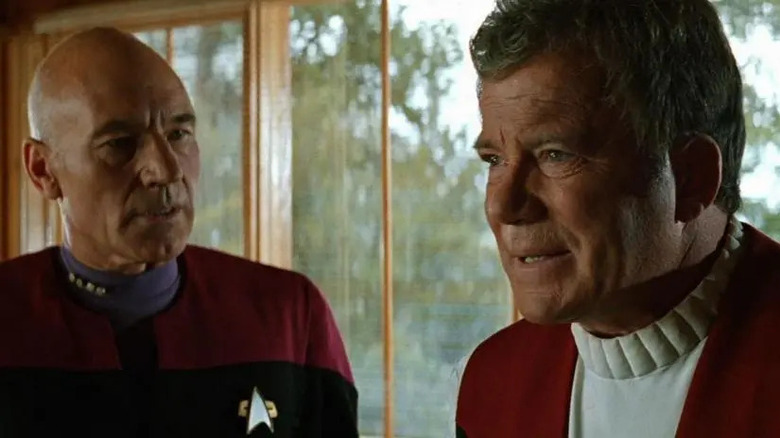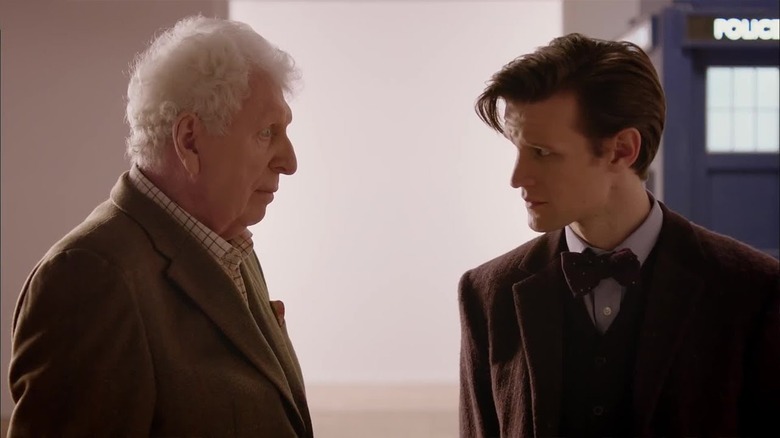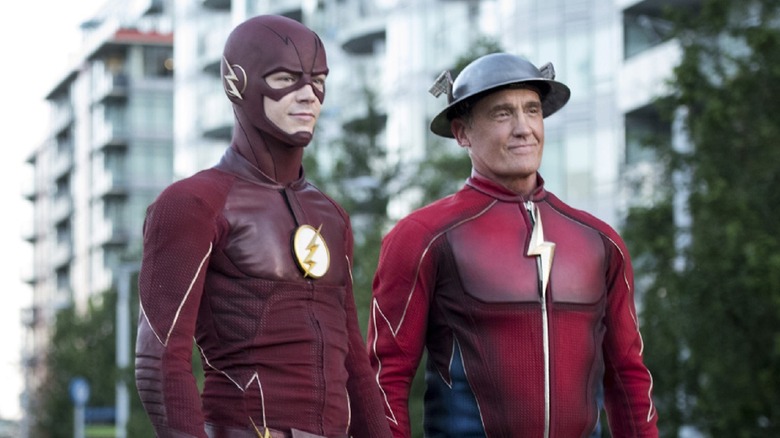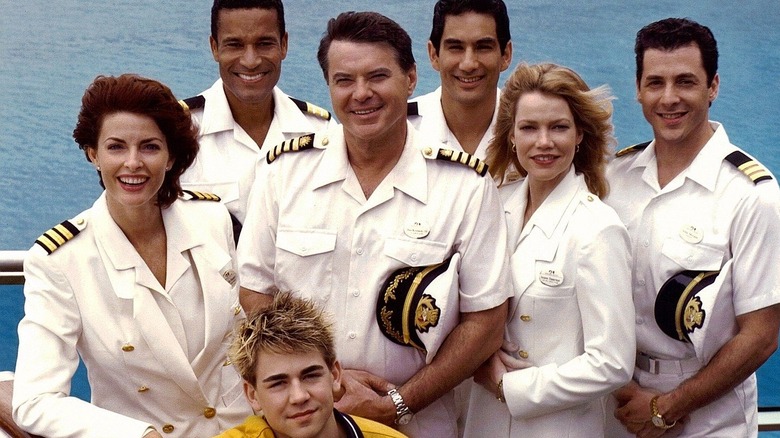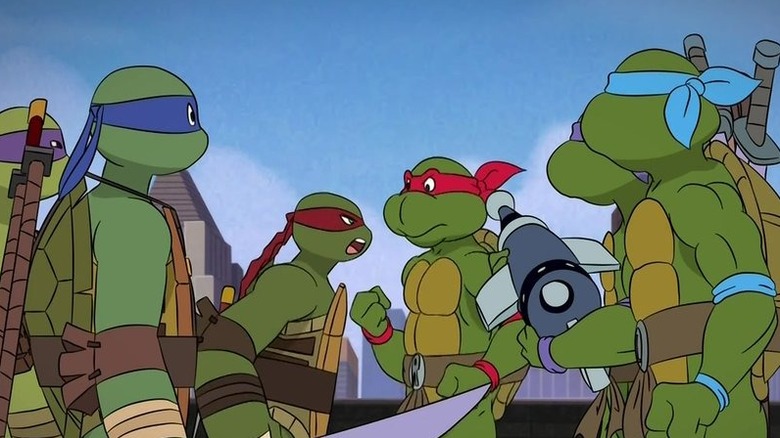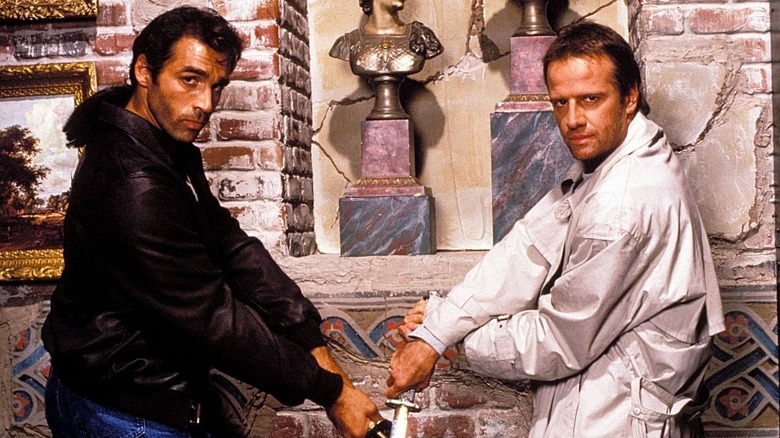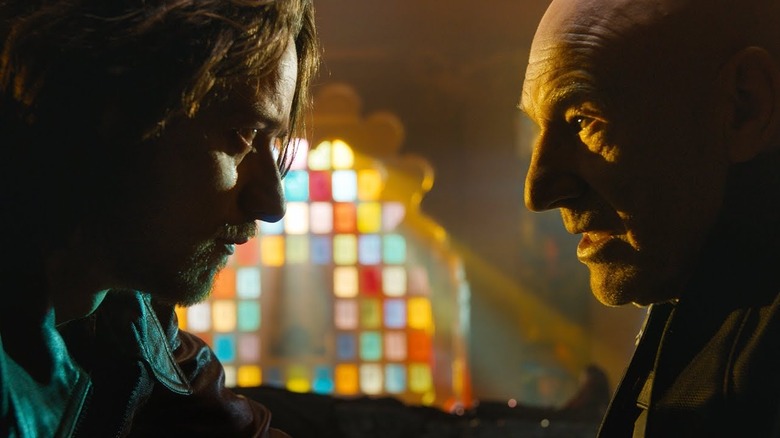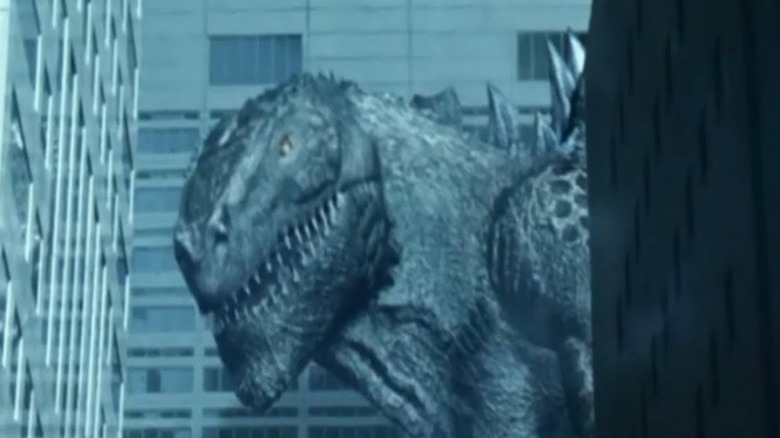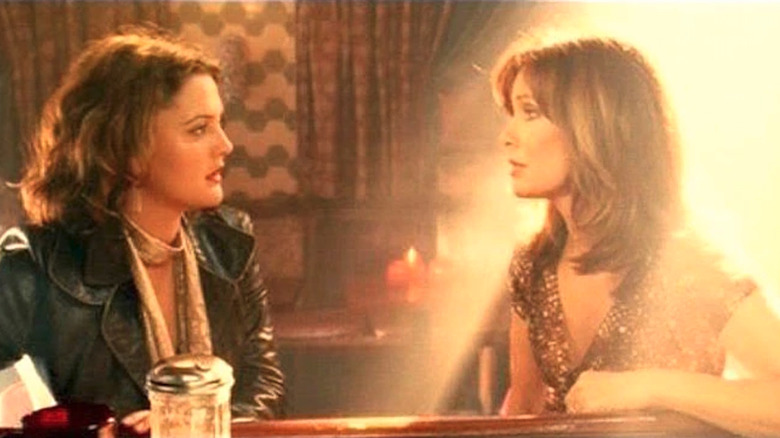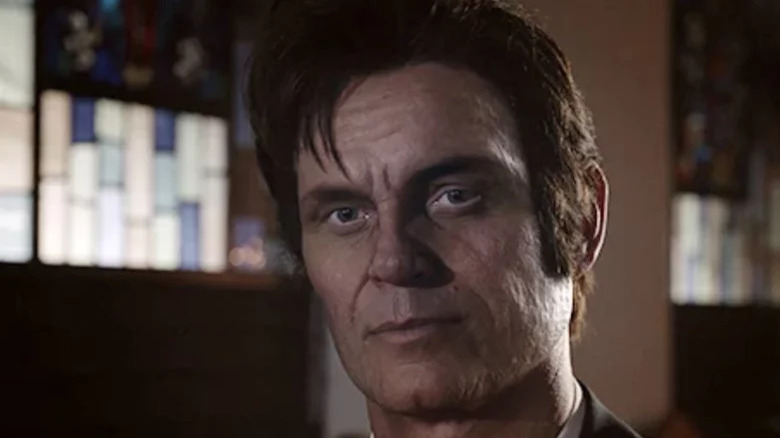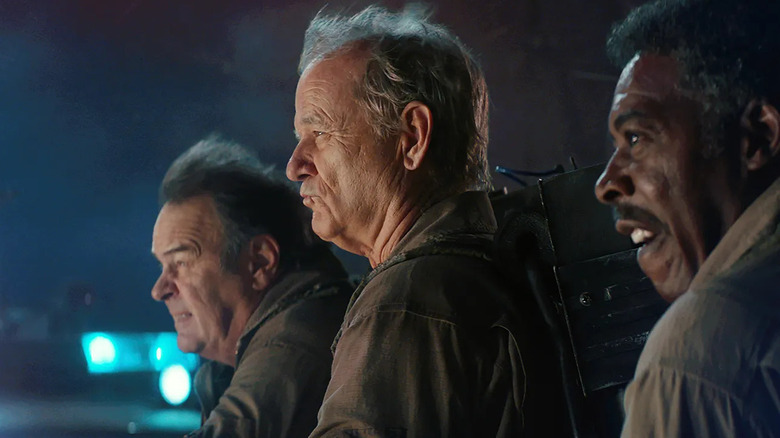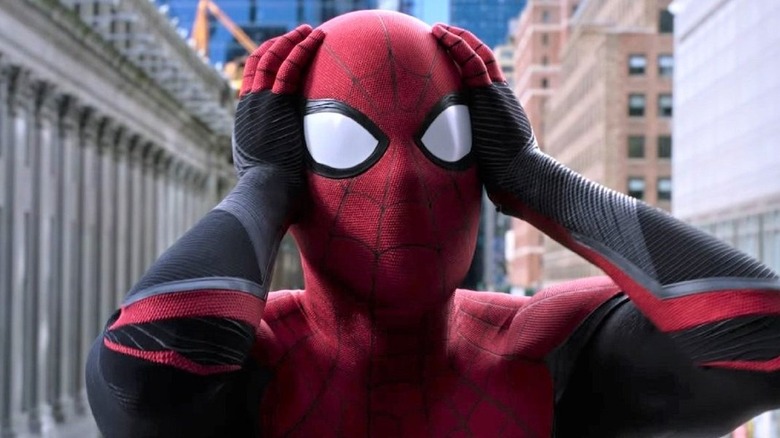Movies And TV Shows That Crossed Over Generations
Television remakes and movie reboots have been around almost as long as the mediums have existed, but it's hard to deny that it feels like there are more revivals now than ever before. The rise of streaming has given audiences unprecedented access to old favorites, and studios are discovering that classic shows and movies are more popular than they ever realized.
But as long as there have been relaunches and reboots, there's been the opportunity for new and old generations to meet up, allowing a new generation to shake hands with its forebears. It doesn't happen often, but when it does, it makes for a very special moment. With next year's "Flash" film featuring not one but two generations of "Batman" heroes in Ben Affleck and Michael Keaton, fans once again get to enjoy this unique experience.
It's certainly nothing new, though. Here's a look back at some other TV shows and movies that have crossed over multiple generations.
Star Trek
Captain Kirk was aboard the starship Enterprise for three seasons in the 1960s and for seven more feature films from 1979 to 1991. Thanks to the success of those films, a spin-off series was launched in 1987 with an all-new ship and crew, this time captained by Patrick Stewart as Jean-Luc Picard. Running for seven seasons, "Star Trek: The Next Generation" brought Stewart to fame and acclaim but never extinguished the public's love for Captain Kirk.
The two captains finally met in the 1994 "Next Generation" feature film, "Star Trek: Generations." In the movie, Kirk is seemingly killed when struck by a space anomaly called "The Nexus," which keeps his mind and body alive. More than 75 years later, Captain Picard is pulled inside the Nexus and meets Kirk, and together they leave the anomaly to stop a diabolical villain. Though not the most beloved "Trek" film, it did what some thought impossible — unite two generations of "Star Trek" in a satisfying team-up that fans had been dreaming of.
Nearly 20 years later, the franchise crossed generations in a big way once again when Leonard Nimoy's Mr. Spock helped shepherd the new, younger crew of the Enterprise back to the big screen in J.J. Abrams' 2009 reboot, "Star Trek."
Doctor Who
Possibly the earliest franchise to unite generations, "Doctor Who" has become famous for its multi-Doctor stories that pair up the day's current Doctor with a former iteration. The first of such stories was "The Three Doctors" in 1972, where Patrick Troughton came back and reprised his role as the Second Doctor and starred alongside Jon Pertwee as the Third Doctor. Alongside them — for pre-recorded scenes due to his declining health — was William Hartnell as the First Doctor.
In 1983 they did it again with "The Five Doctors" — though it's more accurately four, as Tom Baker declined to return and only appears in reused footage — with the Fourth Doctor Peter Davison starring alongside Troughton, Pertwee, and Richard Hurndall as the First Doctor. Three years later, the Fifth and Second Doctors would appear in the episode titled "The Two Doctors" that saw Colin Baker's Doctor meeting the Second Doctor. Decades later, in the modern era, a charity short brought together Peter Davison and Tenth Doctor David Tennant.
The biggest in terms of dramatic scope, however, is "The Day Of The Doctor" which secured long-time holdout Tom Baker, who returned for a single but iconic scene with Eleventh Doctor Matt Smith. While the thrust of the episode had Smith, Tennant, and newly discovered War Doctor John Hurt teaming up to save the universe, it was Baker's tag that was perhaps most memorable.
The Flash
In 1990, actor John Wesley Shipp starred as the Scarlet Speedster in the primetime series "The Flash." It lasted just one season but gained cult status for its ambitious attempt to deliver cinematic superhero thrills on a TV budget. Some 25 years later, "The Flash" premiered on the CW, this time starring Grant Gustin as the speedy superhero. Original "Flash" star John Wesley Shipp appeared in the new series as a nod to his past performance, with his first role being Barry Allen's father, Henry Allen.
He'd pop up later as the "original" 1940s Flash, Jay Garrick, but the role that best qualifies him for this list was in an episode that adapted the classic DC Comics mega-crossover "Crisis On Infinite Earths." There, Shipp suited up as the original 1990s version of Barry Allen once again, more than 40 years after the original series ended. The story brought together multiple generations of DC movie and TV universes, with appearances from Brandon Routh and Tom Welling as their respective versions of Superman, Burt Ward as the 1960s Robin, and even Ashley Scott as the Huntress from the short-lived "Birds of Prey" TV series. More importantly, though, the current movie version of the Flash — played by Ezra Miller – appeared in a surprise cameo, connecting three generations of the hero.
Love Boat: The Next Wave
The original "Love Boat" was a romantic comedy set aboard a cruise ship — the Pacific Princess — that aired for nine seasons between 1977 and 1987. Its casual mixing of soap opera and sitcom made it a beloved mainstay of prime time television in its day. There were even crossovers with other popular network shows like "Charlie's Angels," "Fantasy Island," and "Martin." (The cast appeared in the latter a decade after the series aired its last regular episode.)
In 1998, creator Aaron Spelling revived "Love Boat" with an all-new crew aboard an all-new ship, the Sun Princess. Led by Robert Urich and reboot veteran Phil Morris (who'd also been a part of the 1988 "Mission: Impossible" sequel series), "Love Boat: The Next Wave" gave the classic show a facelift for the late '90s. Though it couldn't match the success of the original — only lasting a brief two seasons — the 2nd season entry, "Reunion," brought together all the stars of the original series for a very special episode. Aboard the Sun Princess, the old crew returns to celebrate the wedding of Jill Whelan to Captain Stubing, who makes sure to get in a few cutting remarks about this new updated ship and crew.
Teenage Mutant Ninja Turtles
The 1987 cartoon "Teenage Mutant Ninja Turtles" was a bonafide '80s phenomenon and touched off an entire industry that changed the face of toys and animation forever, particularly when it came to licensed merchandise. The series ran for 10 years until closing out its run in 1996, at which time the franchise was a veritable empire of toys, games, and movies.
In 2003, an edgier version of the Ninja Turtles debuted, with an updated look and more extreme tone. That series proved almost as successful, running for seven seasons on Nickelodeon. After it concluded, a third series — this time animated in CG — launched in 2012. On several occasions, these three series cross over, first in 2009's "Turtles Forever," when the 2003 Turtles meet their 1987 counterparts and team up to stop a new version of Shredder, whose latest plan threatens to destroy the "omniverse." In 2014, the newest version of the Turtles discovers the 1987 Turtles in a two-part episode of the CG show, and two years later, the two teams meet in the episode "Trans-Dimensional Turtles."
"Turtles Forever" is notable for also featuring an animated version of the original comic book versions of the characters, while "Trans-Dimensional Turtles" found a clever way to tie the series together, revealing that the 1987 Krang originated from the CGI "TMNT" universe but was banished to the 1987 world by his cousin.
Highlander: Endgame
"Highlander" is a 1986 fantasy adventure film starring Christopher Lambert as an immortal warrior named Connor MacLeod, who is at odds with others of his kind in a centuries-long war that takes place in the shadows of modern civilization. Even though it wasn't a box office hit, it nevertheless spawned a sequel in 1991, after which a television spin-off was launched.
The television adaptation, "Highlander: The Series," told the story of an entirely new immortal warrior named Duncan MacLeod, cousin of Connor. Though it doesn't line up perfectly with the film's continuity, it is apparently set in the same universe. The series proved popular in syndication, earning itself six strong seasons and even its own spinoff. And in the middle of its run, a third "Highlander" film — "Highlander III: The Sorcerer" — was released to theaters and continued the story of clan MacLeod with more of Duncan's adventures.
Unfortunately, both of the two "Highlander" film sequels were disappointments in theaters. But two years after "Highlander: The Series" ended, the two MacCleod's met in the theatrically released film "Highlander: Endgame," with both Christopher Lambert and Adrian Paul returning to their respective roles. Possibly an attempt to leverage the success of the television series, the coming together of both heroes was an exciting prospect to fans, but it didn't lead to any more success at the box office.
X-Men: Days of Future Past
Bryan Singer launched the first "X-Men" film in 2000, which led to two sequels and a few spinoffs, but by 2010, it looked like Patrick Stewart's days as Professor X were in the rearview mirror. The following year, director Matthew Vaughn ("Kingsman") relaunched the X-Men films with "X-Men: First Class." Seen as a soft reboot of the franchise, it chronicled the early days of Professor Xavier's mutant team.
At first, there was some confusion among fans as to whether "First Class" was a new series or a straight prequel. Although it was filled with some major changes to the timeline, it also included a Hugh Jackman cameo and appeared to be something in between. But three years later, Singer returned to the director's chair for the movie's sequel, which felt like the perfect time to officially bring Stewart's first trilogy into the mix. In "X-Men: Days Of Future Past," a younger Xavier (played by James McAvoy) gets a telepathic visit from his future counterpart (played by Patrick Stewart), and through time travel shenanigans, they team up to stop a devastating dystopian future from ever happening.
How all of the movies in the series connect is still debated, as there are many contradictory elements, and the "X-Men" timeline never really matches up. Still, "Days Of Future Past" stands as a triumphant blending of two generations of X-Men and one of the better generational crossovers that Hollywood has mustered up.
Godzilla: Final Wars
Godzilla may just be the most famous movie monster in the history of film, and it's sometimes ranked among the best as well. First appearing in the eponymously titled Japanese film "Godzilla" in 1954, the gigantic reptilian monstrosity birthed an entire genre of kaiju films featuring giant monsters destroying Earth. A plethora of sequels and spin-offs were spawned from the 1950s classic, too, including a face-off against America's most famous monster in 1963's "King Kong vs. Godzilla." Other sequels include 1967's "Son of Godzilla" and a more modern update of the original, "Godzilla 1985," in the mid-80s.
In 1998, Godzilla made the jump across the Atlantic with the franchise's first Hollywood production, the Roland Emmerich-directed "Godzilla," starring Matthew Broderick and Harry Shearer. Critically panned, the franchise's owners Toho famously hated the film. In 2004, Toho got their revenge on Hollywood with the release of their own movie, "Godzilla: Final Wars."
In the 2004 film, the classic Godzilla goes toe-to-toe with the 1998 Godzilla, which the Japanese studio refers to only as "Zilla" to keep the American version separated from their classic monster. The fight is exceptionally brief as Godzilla dispatches him with ease, tossing him into the Sydney Opera House and vaporizing him with his atomic breath.
Charlie's Angels: Full Throttle
Spy shows were all the rage in the '60s and '70s, but one show managed to break through the noise thanks to its all-woman cast. At the height of the 1970s feminist movement, "Charlie's Angels" starred Farrah Fawcett, Jaclyn Smith, Cheryl Ladd, Kate Jackson, and others over the course of its five seasons. And the actresses are more than just pretty faces — they're strong young women of action, a team of intrepid secret agents working for a mysterious unseen man named Charlie who sends them on missions to stop all manner of criminals. Ultimately, the series vaulted several of the actresses to notoriety and became a cultural touchstone.
Decades later, it was still a part of the pop-culture consciousness, and a feature film adaptation of the series came to theaters starring Cameron Diaz, Drew Barrymore, and Lucy Liu as the three Angels hit theaters. The movie amped up the action and fireworks and delivered just the kind of modern reinvention the franchise needed. The film had a strong box office showing, and a sequel called "Charlie's Angels: Full Throttle" landed in 2003. Facing off against Demi Moore as ex-Angel turned villain Madison Lee, the Angels are in over their head, but one Angel gets some advice from an unlikely source: original Angel Kelly Garrett in a cameo appearance by Jaclyn Smith.
Smith returned as Garrett again in the 2019 soft reboot of the series, "Charlie's Angels," starring Kristen Stewart, Ella Balinska, and Naomi Scott, and was the only Angel to appear in three generations of the franchise.
Hawaii Five-0
"Hawaii Five-0" began its remarkable 12-season run in 1968. At the time of its ending, it was the longest-running police procedural in television history, since overtaken by the likes of "Law & Order," "Criminal Minds," and "CSI." A classic cop drama, it starred the late Jack Lord as Detective Captain Stephen "Steve" McGarrett, leader of a state police force located on the islands of Hawaii. There he battles everyone from common street punks to deadly snipers, mob bosses, and foreign terrorists and tackles controversial issues like environmentalism and human trafficking. He foils drug deals, assassination plots, and even a few international incidents. McGarrett was TV's one-man war on crime, and the show's unique island setting gave it an exotic flair.
Fast forward a few decades, and CBS relaunched the series in 2010, with a diverse cast that included Daniel Dae Kim ("Lost"), Grace Park ("Battlestar Galactica"), and Alex O'Loughlin as the new Steve McGarrett. This new version aired for a full 10 seasons but never became the cultural touchstone its predecessor was. Still, one important moment that it created in the legacy of "Hawaii Five-0" came in 2016 when O'Laughlin's McGarrett meets the original — resurrected via CGI — in the 7th season premiere. Though the character is never named, the CGI recreation is a retired cop who gives the new McGarrett some advice, and it's clear it's intended to be the original. (However, in the show's mythology, O'Loughlin is actually the son of the original Steve McGarrett.)
Ghostbusters: Afterlife
Created by Harold Ramis and Dan Aykroyd, "Ghostbusters" was 1984's highest-grossing movie, directed by Ivan Reitman and starring both creators alongside Bill Murray, Ernie Hudson, Sigourney Weaver, and Rick Moranis. The story follows four average joe's who discover a hidden world of ghosts and fight the supernatural with the help of specially designed equipment and the Ecto-1, a repurposed hearse. One of the most beloved '80s comedies, it earned itself a sequel in 1989 that wasn't quite as successful but helped start a franchise that led to a pair of animated series and a variety of toys and related merchandise.
Sony's many attempts to revive the franchise with a third film had never come to fruition, but a relaunch in 2016 directed by Paul Feig and starring Melissa McCarthy, Leslie Jones, Kate McKinnon, and Kristin Wiig was a dud at the ticket counter and with audiences. But just five years later, the studio tried again, and the results stood in stark contrast, as a new generation of young heroes rose up to stop a new rising evil. And joining them in the film's finale were none other than the four original Ghostbusters: Ray Stantz (Aykroyd), Peter Venkman (Murray), and Winston Zedmore (Hudson), and in one climactic emotional moment, the ghost of Egon Spengler, as portrayed by a CGI recreation of late actor Harold Ramis.
While the three surviving actors had also appeared in "Ghostbusters: Answer The Call," they were new characters and not much more than glorified easter eggs. In the 2021 film, however, it was a true union of two generations of Ghostbusters.
Spider-Man: No Way Home
The first big-budget Hollywood adaptation of Marvel's most famous superhero landed in theaters in 2002. "Spider-Man," directed by Sam Raimi, turned Tobey Maguire into a star, and across three films featured some of the web-slinger's most iconic villains, including the Green Goblin, Doctor Octopus, and Venom. After three films, though, director Raimi abandoned a proposed fourth film, and Sony decided to reboot the franchise. What they delivered was "The Amazing Spider-Man" and its sequel, starring English actor Andrew Garfield. Both films did poorly with critics, and diminishing returns left a third film unlikely.
Enter Marvel Studios, whose own cinematic universe was booming by the time "Amazing Spider-Man 2" was in theaters. In an unprecedented move, the two rival studios teamed up to relaunch the series a second time and integrate Spider-Man into the growing MCU. The result was "Spider-Man: Homecoming," "Spider-Man: Far From Home," and the inclusion of the wall-crawler in Marvel's "Infinity War" saga, which put Spider-Man front and center in the Avengers crossover films. But the biggest crossover was yet to come, with 2021's "Spider-Man: No Way Home," which sees Doctor Strange accidentally ripping a hole in the multiverse and bringing villains from the previous non-MCU movies — and both Maguire and Garfield back as their versions of Spider-Man — into the MCU.
